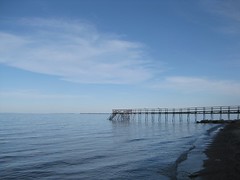the problem with phospherous
Fact: Approximately 8,000 tonnes of phosphorus enter Lake Winnipeg each year, through sewage and agricultural drain-off. A fraction of this will flow-out (2500 tonnes), but the rest remains in the lake.
Fact: Algae use phosphorus to survive and grow. The growing accumulation of phosphorous (and other chemicals) in the lake are causing algal blooms to occur at an alarming rate. Not only are the blooms more frequent, they are bigger in surface area, faster growing, and difficult to control.
Typically it is blue-green algae that naturally forms these blooms. This type of algae can obtain the nitrogen they need from nitrogen in the air, unlike other kinds of algae that take their nitrogen from the water, so as long as they are exposed to air, they can continue to make their own. As a result, the blue-green algae cannot be controlled by reducing the nitrogen supply to them.
Increased blue-green algae causes several negative things to occur in the lake. It causes water to become turbid and unattractive and can produce toxins That make the water taste and smell unappealing. In addition, when the blue-green algae dies it sinks to the bottom of the lake. The decomposition of the blue-green algae consumes the oxygen in the water causing other aquatic organisms to suffocate.
What can we do? As with anything, change starts at home. Choose 100% phosphate-free dishwasher and laundry detergents. These are the main culprits, but check other household cleaners for phosphates, too. I have discovered two things about phosphate-free detergents: they are a little more expensive than “regular” detergents and they work every bit as well.
If you choose to fertilize your lawn (and don’t get me started on that one…), be sure to use ones that contain no phosphorous. (Phosphorous is indicated by the second number on the label. If you are unsure, just ask at the garden centre.)
http://www.lakewinnipegfoundation.org



No comments:
Post a Comment